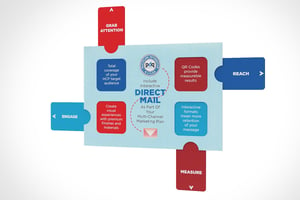Reaching healthcare professionals (HCPs) continues to present a challenge for marketers navigating...
Healthcare marketing has become a high-stakes discipline—especially for pharmaceutical manufacturers and B2B healthcare companies navigating complex buyer journeys and evolving digital expectations. Competing successfully today requires more than promotional outreach; it demands precise strategy, personalized execution, and deep market insight.
To build and sustain competitive advantage, marketers must distinguish between strategy—the long-term plan for reaching the right audience with the right message—and tactics—the specific, measurable actions that bring the plan to life.
This guide outlines the most relevant strategies and high-impact tactics B2B healthcare marketers need to connect with decision makers, accelerate engagement, and drive meaningful business outcomes.
Key Takeaways
- Start With Strategy: Define the problem, know your audience, and map the buyer journey before launching any campaign.
- Use Targeted, Personalized Tactics: High-impact tactics including email, direct mail, SEO, and video work best when tailored to how HCPs engage.
- Leverage AI and Real-Time Analytics: AI is transforming targeting and content delivery. Tools such as HubSpot help track performance and guide optimization.
- PDQ Communications Delivers Results: PDQ combines healthcare expertise and tactical execution to help brands drive engagement and measurable ROI.
Strategic Foundations
Before launching any campaign, you need strategic clarity: what problem you’re solving, who you’re targeting, how they make decisions, and how personalized your approach must be to engage them. These foundations shape everything—your messaging, creative, channels, timing, and conversion strategy. Below are three core strategic pillars every B2B healthcare marketing team should establish before executing tactics.
1. Segmentation and Targeting
Effective healthcare marketing starts by clearly defining the problem your product or service solves, such as improving patient outcomes, streamlining operations, reducing costs, or addressing a clinical gap. The next step is identifying who feels that pain the most and who is in a position to act on it.
In B2B healthcare, that often includes:
- Key decision makers in provider organizations, health systems, and pharmaceutical networks
- Purchasing managers, medical directors, and procurement officers
- Clinical and operational stakeholders with budget authority or influence
Aligning your segmentation to the problem you’re solving helps ensure your campaigns are relevant and focused. Use firmographics, role-based personas, and behavioral data to build segments that reflect real buyer needs so your messaging speaks directly to their challenges and drives stronger engagement.
2. Defining the Buyer Journey
Healthcare purchasing decisions are rarely quick or linear—they’re deliberate, high-stakes, and often made by committee.
Mapping the buyer journey helps you understand:
- What questions buyers ask at each stage
- Which content formats support their decision-making
- How long the sales cycle typically lasts
This insight enables you to align your campaigns to each phase, from early-stage awareness and education to evaluation and final decision-making.
3. Account-Based Marketing (ABM)
ABM is a strategy—not a tactic—because it starts by aligning sales and marketing around a shared list of high-value accounts. Instead of targeting broadly, ABM focuses resources on your most valuable prospects and personalizes outreach across channels.
Why it’s essential in B2B healthcare:
- Sales cycles are long, complex, and involve multiple stakeholders across departments.
- Budget decisions are often centralized, making generic outreach ineffective.
- ABM increases ROI by minimizing waste and focusing on accounts with the highest potential.
When done well, ABM guides how you prioritize accounts, allocate resources, and engage decision makers to drive the highest return.
High-Impact Tactics
With your strategic foundation in place, execution is where momentum builds. The following high-impact tactics reflect what’s working in B2B healthcare marketing—prioritizing relevance, personalization, and precision across digital and physical channels.
1. Email Marketing
Email remains a top-performing B2B channel because it enables tailored, low-pressure communication over time. HCPs value content that respects their time and aligns with their interests. Behavioral segmentation, thoughtful timing, and value-driven messaging (not just promotions) help build trust and engagement. Use email to deliver educational assets, support clinical relevance, and guide decision makers through long consideration cycles.
2. Direct Mail
Amid rising digital fatigue, physical mail stands out. For busy HCPs, personalized, tactile outreach—especially dimensional mailers or data-driven pieces—can grab attention and drive recall. When paired with digital follow-up (QR codes, PURLs, or retargeting), direct mail becomes a powerful multichannel catalyst for engagement.
3. SEO in the Age of AI
Artificial Intelligence (AI) is reshaping how HCPs discover information. Google’s AI Overviews and generative AI platforms (e.g., OpenAI, Anthropic) now synthesize results into conversational answers, often without users clicking through to websites. That means your content must earn a place not just on results pages, but inside AI-generated responses.
SEO still matters, but its role has evolved. It’s no longer primarily about ranking high; it’s about being referenced by AI and search engines as a credible, authoritative source.
That requires:
- Expert-authored, evidence-backed content that signals trust and credibility
- Structured data and schema markup to help AI interpret and surface your content accurately
- Clear, concise answers to buyer questions across every stage of the decision journey
4. Video Marketing
Video is essential—and YouTube is one of the most-used search engines for professional learning. Short, high-value formats including product demos, thought leadership clips, and animated explainers help clarify complex healthcare solutions. They’re also easily repurposed across channels, including email and social.
5. Social Media
For B2B healthcare marketers, LinkedIn (LI) is the most effective platform for engaging healthcare professionals and decision makers. According to LI, healthcare conversations are thriving: 73% of healthcare decision makers use LinkedIn to research business decisions, and the platform has seen a 43% year-over-year increase in content engagement from healthcare professionals. This makes it a powerful space for thought leadership, peer connection, and product discovery.
Use LinkedIn to:
- Share clinical insights, patient impact stories, and white papers
- Reach targeted roles by seniority, specialty, or organization type
- Support ABM through coordinated sales and marketing outreach
While LinkedIn leads in long-form B2B engagement, X (formerly Twitter) can add value in real time. Data analytics firm Definitive Healthcare notes the social media platform’s use in medtech for engaging digital opinion leaders, sharing regulatory updates, and amplifying conference presence—making it ideal for staying visible in ongoing healthcare conversations.
6. Free Trials, Demos and Risk-Free Pilots
In categories such as diagnostics, devices, and clinical workflow tools, offering free trials or pilot programs reduces friction and builds confidence. For pharmaceuticals or treatments, this may take the form of sample programs or limited distribution initiatives within targeted organizations. These programs also create valuable feedback loops and can be integrated into ABM or nurture campaigns.
7. Marketing Automation
Automation is more than a tool, it’s the operational layer that brings strategy to life. Platforms such as HubSpot enable you to leverage segmentation, behavioral data, and campaign performance insights to deliver relevant, timely outreach at scale. When used effectively, it supports lead nurturing, sales enablement, and precision targeting—all with measurable ROI.
In many cases, it functions as a strategic engine, not just a delivery mechanism.
8. AI Applications Beyond SEO
Aside from transforming search behavior, AI is becoming a powerful tool across the healthcare marketing stack, helping teams work smarter, scale faster, and personalize more precisely.
In B2B healthcare, AI can be deployed to:
- Enhance targeting with predictive analytics to refine audience segmentation and media spend
- Accelerate lead qualification through AI-powered chatbots and virtual agents
- Personalize content delivery by dynamically adapting emails, landing pages, and nurture flows based on behaviors and preferences
When used thoughtfully, AI doesn’t just automate; it can amplify strategic intent, driving both efficiency and ROI across campaigns.
Measurement: Don’t Guess—Track
Even the best campaigns fall short without clear measurement. To drive continuous improvement, healthcare marketers need to track what’s working, what’s not, and where to optimize next.
Use platforms such as Google Analytics 4 and HubSpot to track performance KPIs, including:
- Lead quality and pipeline velocity
- Email and direct mail engagement
- Content conversion rates
- ROI by channel and campaign
Campaigns should evolve based on performance. Let the data guide your next move.
Partner With PDQ Communications to Drive Results
Healthcare marketing isn't just about reaching the right people, it's about engaging them with intelligence, precision, and proven expertise. PDQ Communications is your strategic partner for implementing the essential marketing strategies and tactics that maximize results in today's complex healthcare landscape.
Whether you're looking to refine your segmentation approach, launch sophisticated ABM campaigns, or integrate multi-channel tactics such as SEO, video marketing, and targeted direct mail, PDQ combines deep healthcare industry knowledge with tactical execution expertise. We understand the unique challenges of reaching HCPs and healthcare decision makers, from navigating compliance requirements to cutting through information overload.
Our integrated approach ensures every strategy and tactic works together seamlessly—from foundational targeting frameworks to advanced channel optimization—delivering the measurable business outcomes that matter most to pharmaceutical and healthcare marketing leaders.
Ready to transform your marketing performance with strategies that work?








